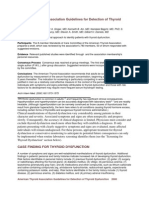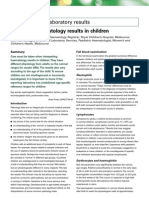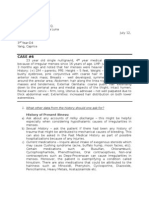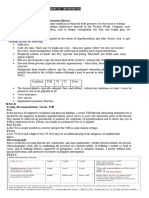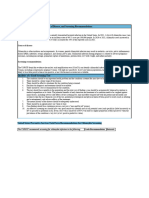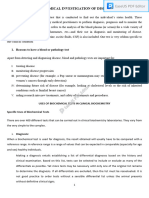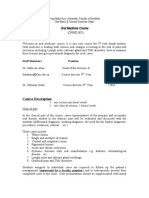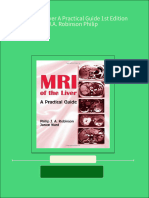Avoiding Unnecessary Laboratory Tests May 2008
Avoiding Unnecessary Laboratory Tests May 2008
Uploaded by
Danielcc LeeCopyright:
Available Formats
Avoiding Unnecessary Laboratory Tests May 2008
Avoiding Unnecessary Laboratory Tests May 2008
Uploaded by
Danielcc LeeOriginal Description:
Copyright
Available Formats
Share this document
Did you find this document useful?
Is this content inappropriate?
Copyright:
Available Formats
Avoiding Unnecessary Laboratory Tests May 2008
Avoiding Unnecessary Laboratory Tests May 2008
Uploaded by
Danielcc LeeCopyright:
Available Formats
CSP
A REGULAR CASE-BASED SERIES ON PRACTICAL PATHOLOGY FOR GPs
MAY 2008
Common Sense Pathology
CONTENTS
When to perform a diagnostic test Which test is appropriate Case studies
AVOIDING unnecessary
laboratory tests
A JOINT INITIATIVE OF
The Royal College of Pathologists of Australasia
AVOIDING UNNECESSARY LABORATORY TESTS
Professor Geoffrey Kellerman,
VMO in Chemical Pathology, Hunter Area Pathology Service, NSW.
Dr Anoop Enjeti,
Staff Specialist in Haematology, Calvery Mater, Newcastle, NSW.
Introduction
Unnecessary laboratory tests may be defined as those that have a vanishingly small chance of: revealing any unexpected pathological process. contributing to the diagnosis of the cause of a patients presenting symptoms. assisting in the monitoring of the progress of a known pathological process. helping to assess the management of a known disease process.
This issue of Common Sense Pathology is a joint initiative of Australian Doctor and the Royal College of Pathologists of Australasia. It is published by Reed Business Information Tower 2, 475 Victoria Ave, Locked Bag 2999 Chatswood DC NSW 2067. Ph: (02) 9422 2999 Fax: (02) 9422 2800 E-mail: mail@australiandoctor.com.au Web site: www.australiandoctor.com.au (Inc. in NSW) ACN 000 146 921 ABN 47 000 146 921 ISSN 1039-7116 2008 by the Royal College of Pathologists of Australasia www.rcpa.edu.au CEO Dr Debra Graves E-mail: debrag@rcpa.edu.au While the views expressed are those of the authors, modified by expert reviewers, they are not necessarily held by the College. Cover: Needle in a haystack. Greg Smith/Index Stock Imagery.
Common Sense Pathology editor: Associate Professor Huy A Tran E-mail: huy.tran@hnehealth.nsw.gov.au Chief sub-editor: Jacqueline George E-mail: jacqueline.george@reedbusiness.com.au Australian Doctor Editor: Dr Kerri Parnell E-mail: kerri.parnell@reedbusiness.com.au Medical editor: Dr Annette Katelaris E-mail: annette.katelaris@reedbusiness.com.au Commercial director: Suzanne Coutinho E-mail: suzanne.coutinho@reedbusiness.com.au Graphic designer: Edison Bartolome E-mail: edison.bartolome@reedbusiness.com.au Production manager: Ray Gibbs E-mail: ray.gibbs@reedbusiness.com.au
For an electronic version of this and previous articles, you can visit www.australiandoctor.com.au Click on Clinical and Library, then Common Sense Pathology. You can also visit the Royal College of Pathologists of Australasias web site at www.rcpa.edu.au Click on Publications and Forms, then Common Sense Pathology. This publication is supported by financial assistance from the Australian Government Department of Health and Ageing.
The millions of dollars spent on unnecessary tests are, in [doctors] minds, balanced against the tens of millions involved in adverse court judgments.
Unnecessary laboratory tests may not be harmless. Most test reference ranges include 95% of the population, so when multiple tests are performed there is a high probability that at least one will be flagged as outside the normal range. This often leads to patient and/or doctor anxiety, followed by more expensive or invasive follow-up tests, and even therapies that are not indicated. Unnecessary tests also increase costs. However, with the increase in litigation, the perceived bias of the legal system against the doctor and the lack of an agreed definition of the term vanishingly small, many practitioners adopt a defensive strategy and test for whatever is convenient at each patient visit. The millions of dollars spent on unnecessary tests are, in their minds, balanced against the tens of millions involved in adverse court judgments. Frequently patients have to travel or take time off work for medical appointments, and the convenience of having all tests performed on one occasion may also be a significant factor. The following five common case scenarios aim to assist GPs when making the decision to order relevant laboratory investigations.
Case study 1
QC, 61, comes for a check up before going on a trip overseas. She is in good health and has no relevant history. She has travelled overseas several times before with no problems.
Should you perform a thyroid test, and if so, which one?
About 5% of the female population in Australia will develop some degree of asymptomatic hypothyroidism, most over the age of 50. So, it is reasonable to check QCs thyroid function if it has not been done (that is, you have no record and she has no memory of such a test) within the past five years. The current expert recommendation for such a patient is not more frequently than every five years, because it is unlikely that significant thyroid disease will develop more rapidly at this age. The Royal College of Pathologists of Australasia recommendation and Medicare policy is to only measure thyroid-stimulating hormone (TSH) and then follow with further tests if it is outside the reference range of 0.4-4.0 mU/L. If the patient has a moderate-to-severe acute illness, which this patient does not, then following up a modestly low TSH value is not worthwhile until the patient has
Glucose and ketones on urinary dipstick in a symptomatic child mandate urgent referral which should not be delayed by confirmatory tests.
completely recovered, as illness may temporarily suppress the pituitary thyrotrophs.
What advice should be given about travel and venous thrombosis?
Despite extensive coverage in the lay press, the association between prolonged air or land travel and venous thrombosis remains controversial. The studies performed do not show any consistent additional risk factors that may help predict the occurrence of DVT during or after air travel. Thrombophilia testing should not be routinely performed if there is no personal or family history of thrombosis because 5% of people of European descent will have genetic polymorphisms for thrombophilia but will never have a thrombotic event. Avoiding constrictive clothing around lower extremities or waist, keeping well hydrated and frequently stretching calf muscles have been recommended as the steps for long-distance travellers (ie, flights of more than six hours) to prevent thrombosis occurring. Currently, there is no evidence to support the use of compression stockings to prevent DVT. The following tests are not generally recommended: TSH, in the absence of symptoms, in males or females younger than 50 years of age. Free-thyroid hormones: TSH is the recommended screening test for symptomatic thyroid disease. If
TSH is elevated, suggest FT4 level only. If TSH is low, FT3 and FT4 are recommended. Thrombotic screen in the absence of any symptoms or signs of thrombosis.
Case study 2
DL, a child aged 10, has a short history of thirst and weight loss and has relapsed into bed wetting at night. Urine dipstick shows 3+ glycosuria and a trace of ketones.
Should you request a glucose tolerance test (GTT) to confirm diabetes? If yes, what dose of glucose is appropriate?
No, you should not order a GTT for this patient. Glucose and ketones on urinary dipstick in this symptomatic child mandate urgent referral which should not be delayed by confirmatory tests. In general, never do a GTT in a child before first measuring a fasting or random blood glucose. In this patient, a hypertonic glucose load (the glucose drink is about 1400 mOsm/L) will further increase the blood sugar and lead to a more intense glycosuria with the potential to further dehydrate the child. This risk is greater in children but also present in adults. In general, diabetes is confirmed by the finding of raised fasting blood glucose of 7.0mmol/L or more on two occasions. In a symptomatic child, a random plasma glucose of more than 11.1mmol/L or a fasting blood glucose of more than 7.0mmol/L confirms the diagnosis.
Urgent insulin treatment is necessary, if there are signs of significant ketoacidosis (* 2+ ketonuria) such as hyperpnoea, hypotension, low bicarbonate or excessively high blood sugar on the first sample. This child, whose initial blood glucose level was found to be 25mmol/L, certainly warranted inpatient observation and care.
Should you order a set of tumour markers (such as carcinoembryonic antigen, carbohydrate antigen 19.9, human chorionic gonadotropin, alpha-fetoprotein)?
This is not a recommended strategy. Tumour markers are not very sensitive. In more than 50% of cancers, they are not raised, especially early in the disease. Also, at slightly elevated levels they are not very specific because they can be secreted by organs involved in other pathological processes. For example, a moderate increase in one or more of these markers may occur in chronic liver disease, either non-alcoholic steatorrhoeic hepatitis or cirrhosis. Therefore, no increase does not exclude a malignancy and a moderate increase can lead to a false diagnosis or a false expectation by the patient regardless of the doctors opinion. The major value of such markers is for monitoring recurrence or persistence of tumours after treatment of a hormone-secreting tumour. The jury is still out on the role of PSA. Summary of inappropriate use of tumour markers: A test with low sensitivity does not exclude a diagnosis and leads to false reassurance. A test with low specificity can lead to misdiagnosis with subsequent morbidity and mortality. When used appropriately, tumour markers can help to monitor a disease.
Should you request a HbA1c at the initial visit to confirm diabetes?
No. The Medicare recommendations are that this test is applicable only in a patient with established diabetes, that is with two fasting blood glucose levels more than 7.0mmol/L, or in an older patient with fasting glucose in the impaired glycaemic control region (6.1-7.0mmol/L) and GTT results of a fasting blood glucose * 7.0mmol/L or twohourly blood glucose * 11.1mmol/L. This patient is so ill that the diagnosis could be made at the initial consultation and the HbA1c would be justified, but the result may be difficult to interpret as the history is so short and the lifetime of the red cell is three months.
Having established the diagnosis of diabetes, should the HbA1c be measured at every visit?
Probably not. Initially visits are likely to be more frequent than the three-monthly measurement permitted by Medicare this is in keeping with the lifetime of the red cell. Key points: Screening tests are not indicated when the diagnosis is clear. HbA1c is not recommended as a diagnostic test for diabetes. The ordering of tests should be evidence-based and should comply with Medicare rules. Any test with potential for harm should be avoided.
Case study 4
GR, 47, complains of crushing chest pain radiating down his left arm for one hour, with sweating and a feeling of weakness. On examination, his blood pressure is 110/60mmHg (normally 140/85mmHg) and ECG shows 3mm elevation of the ST segments in V3-V6 leads.
Case study 3
FS, 61, has been feeling mildly unwell for about a month with some anorexia, and has had an unintentional weight loss of 4kg. Physical examination is normal.
Should you immediately measure troponin and cardiac enzymes (such as creatine kinase [CK], aspartate aminotransferase [AST], lactate dehydrogenase [LD]) to assist in the diagnosis of MI, before commencing anticoagulant or thrombolytic therapy?
No. There is evidence of an extensive anterolateral infarct (symptoms in the presence of hypotension
and four chest leads with ST elevation) and therapy should be commenced as soon as possible because time is muscle. The delay involved in waiting for test results will extend the area of muscle death. With the availability of the highly specific cardiac marker troponin, AST and LD should no longer be used as markers of MI because they are not specific to cardiac events. It is important to remember that neither troponin or CK begins to rise until at least 4-5 hours after an MI.
its measurement is more difficult, especially in low concentrations, and many laboratories have largely discarded this test. It may be a better indicator for reinfarction, but the delay in obtaining results when the test needs to be sent away limits its usefulness. Key points: Do not delay diagnosis and therapy of MI when the diagnosis is clear. Do not waste resources on baseline tests that have unhelpful results. Do not repeat tests when the diagnosis is well established if they have no real role in monitoring progress.
Would knowledge of a baseline level of troponin and CK (at the time of the infarct) be of any value in assessing the degree of damage?
Baseline CK may be of value, as there is always some present in plasma. The increase above this level at 24 hours post-infarct is moderately well correlated with the mass of infarcted tissue, although the relationship changes if the patient has been thrombolysed. Baseline troponin is of no value, as it would be close to zero. However, if previous infarction in the past week or two is suspected, it is worth measuring because it may be elevated. The increase in troponin at 24 hours is correlated with the infarct size in the absence of thrombolysis, but after this procedure there is such a rapid and variable washout that the correlation is quite poor.
Case study 5
AC, 55, attends her doctor for the first time in three years for a general checkup, because she finds she has less energy and is considering giving up her part-time secretarial job. She had two uncomplicated pregnancies (at age 24 and 27) and has had no significant health problems. She has gained 3kg in the past five years, does not smoke and drinks one or two glasses of wine each night. Her diet is reasonably balanced apart from an almost total avoidance of red meat. She takes no regular medications (HRT was used for two years and stopped three years ago) and no over-the-counter medications apart from occasional paracetamol for headaches. Examination is normal apart from a blood pressure of 160/90mmHg, which settles to 145/90mmHg after 10 minutes. Urine dipstick analysis is negative.
Should you repeat the troponin measurement daily to observe progress? Will it help predict cardiac rupture or later failure?
As troponin levels decline with a half life of 2-3 days, there would seem to be no point in observing this process. Some cardiologists believe that it provides evidence for repeated infarction after the first episode, but as CK levels drop much more quickly this enzyme is probably a better marker for reinfarction, and new ECG changes may be even better. There is no evidence that troponin levels help predict rupture or failure, except in so far as the larger the infarct the greater the chance of later cardiac failure.
What is the role, if any, of CK-MB now that troponin is available?
CK-MB has a slightly shorter half life than CK itself, and much shorter than troponin. However,
Which of the following investigations can you justify on this initial visit? FBC; iron studies and ferritin; coagulation screen electrolytes, urea and creatinine liver function tests; glucose HbA1c; lipid studies; thyroid tests urine or blood catecholamines; cortisol faecal occult blood test calcium, phosphate, magnesium and vitamin D tumour markers arterial blood gas
Unnecessary laboratory tests may not be harmless. Most test reference ranges include 95% of the population, so when multiple tests are performed there is a high probability that at least one will be flagged as outside the normal range.
You are investigating this patient for a possible physical cause to explain her loss of energy. The differential diagnosis includes: anaemia, hypertension, early renal impairment, excess alcohol intake, a psychological problem or any one of many rare conditions. A FBC is essential and may rule out anaemia or reflect a major systemic illness given the range of pathophysiological conditions in which it may be abnormal. For example, microcytic hypochromic anaemia may indicate a nutritional deficiency (which may be relevant in this woman who avoids red meat) or a blood loss anaemia (occult gastrointestinal malignancy). Routine iron studies may not provide any additional useful information unless it is part of follow up of a low haemoglobin or treatment monitoring. The serum ferritin can be raised in a variety of inflammatory conditions and serum iron is not a reliable marker of iron stores. Given the lack of specificity of the iron studies, a normal study does not exclude iron deficiency. Serum B12 and red cell folate levels are useful screening tests in this setting. Serum B12 (in the context of meat avoidance) or red cell folate could
be low and can, albeit uncommonly, cause neurological symptoms without anaemia. It is recommended that a serum red cell folate is ordered rather than serum folate alone as the latter does not accurately reflect folate stores in the body. Coagulation testing is not routinely recommended. It could only be justified if the patient is on an oral anticoagulant or has a specific bruising/ bleeding complaint. Mild prolongation of coagulation profiles due to technical issues associated with collection and testing is not uncommon and leads to unnecessary and expensive repeat testing or investigations. Unless a specific question from the history or examination is being addressed these tests should not be routinely performed. Testing urea, creatinine and electrolytes can be justified as this patient is mildly hypertensive and these tests will give a measure of renal function and allow calculation of her estimated GFR, as well as pointing to any electrolyte disturbance. Liver function tests are appropriate to exclude excessive alcohol intake. Gamma glutamyltransferase rises in about 40% of such patients even in the absence of transaminase increases. Albumin will
An FBC is an essential screening test that may rule out anaemia or reflect a major systemic illness given the range of pathophysiological conditions in which it may be abnormal.
decrease if nutrition has been chronically poor. Hepatitis is unlikely, but if she had received a blood transfusion before hepatitis screening of blood was available then it could have been acquired. Diabetes is common and often symptomless so a fasting blood glucose test is justified, even in the absence of glycosuria. As mild hypertension and diabetes (or even impaired glycaemic control) are risk factors for coronary vascular disease, it may be reasonable to measure low-density and highdensity lipoprotein cholesterol or total cholesterol and fasting triglycerides. There are good arguments for adding calcium and phosphate to the electrolyte screen, at least occasionally, as there is no other way to exclude hyperparathyroidism. Vitamin D levels are not worth doing in an ambulatory patient of this age unless they have very limited exposure to sunlight. There is mounting evidence that there is a substantial group in the population who have limited sun exposure and, subsequently, low vitamin D levels, and those people should be intermittently checked. Of course, these tests are of no value in diagnosing or monitoring osteoporosis. The National Bowel Cancer Screening Program involves faecal occult blood testing for all adults reaching the ages of 55 or 65 during 2006-08 with follow-up colonoscopy if positive. It is anticipated
that the program will be extended to all in these age groups as resources for the follow ups become available. At present, for those who dont come under the screening program, such testing can be done at the patients own expense. Catecholamines are not justified in this patient, as the hypertension is mild, not episodic and phaeochromocytoma is rare. Arterial blood gas is inappropriate and is reserved for significantly sick patients in hospital. See discussion of Case study 1 (thyroid tests), Case study 2 (HbA1c) and Case study 3 (tumour markers). Summary of recommended tests in this case: FBC, serum electrolytes and creatinine, liver function tests, fasting glucose, calcium, phosphate, fasting cholesterol and triglyceride, serum B12 and red cell folate levels. Other tests are to be guided by symptoms and history taking.
Further reading
Dunstan R (ed). Abnormal Laboratory Results. McGraw-Hill, Sydney, 2005.
You might also like
- ATLS Post TestDocument1 pageATLS Post Testanon_57896987836% (56)
- Clinical Internal Medicine Review 2023: For USMLE Step 2 CK and COMLEX-USA Level 2From EverandClinical Internal Medicine Review 2023: For USMLE Step 2 CK and COMLEX-USA Level 2Rating: 4 out of 5 stars4/5 (2)
- USMLE Step 3 Lecture Notes 2021-2022: Internal Medicine, Psychiatry, EthicsFrom EverandUSMLE Step 3 Lecture Notes 2021-2022: Internal Medicine, Psychiatry, EthicsRating: 5 out of 5 stars5/5 (9)
- Mksap 15 General Internal MedicineDocument181 pagesMksap 15 General Internal MedicineEzequiel Meneses100% (1)
- GTG 43Document14 pagesGTG 43jhjgfNo ratings yet
- Theories and Models of Disease CausationDocument62 pagesTheories and Models of Disease Causationsunielgowda100% (1)
- Clinical Voice 28 PaginasDocument28 pagesClinical Voice 28 PaginasCarlos Carrasco100% (1)
- Nle Tips May2015Document15 pagesNle Tips May2015Randy100% (2)
- Nle Tips Pls Read.. Dali DaliDocument15 pagesNle Tips Pls Read.. Dali DaliRandyNo ratings yet
- PreventionDocument7 pagesPreventionasuratosNo ratings yet
- Lession 4 Adrenal IncidentalomasDocument8 pagesLession 4 Adrenal IncidentalomasjmohideenkadharNo ratings yet
- Diabetes Diagnosis and Monitoring, April 2002 Author Peter ColmanDocument13 pagesDiabetes Diagnosis and Monitoring, April 2002 Author Peter ColmanDanielcc LeeNo ratings yet
- GERIATRICS 2024 Feb CompilationDocument14 pagesGERIATRICS 2024 Feb CompilationKonain SiddiqueNo ratings yet
- Health Screening - StatPearls - NCBI BookshelfDocument3 pagesHealth Screening - StatPearls - NCBI BookshelfOviedo RocíoNo ratings yet
- Screening in Surgery DR Bashiru Aminu: Moderator A. MaiDocument30 pagesScreening in Surgery DR Bashiru Aminu: Moderator A. MairoselinekhadijaNo ratings yet
- COLON CANCER - Group 4Document22 pagesCOLON CANCER - Group 4Deinielle Magdangal RomeroNo ratings yet
- Endocrinology ReferralDocument3 pagesEndocrinology Referralioana.gl0496No ratings yet
- Ulcerative Colitis Brochure PDFDocument2 pagesUlcerative Colitis Brochure PDFicoanamareNo ratings yet
- American Thyroid Association Guidelines For Detection of Thyroid DysfunctionDocument5 pagesAmerican Thyroid Association Guidelines For Detection of Thyroid DysfunctionUdsanee SukpimonphanNo ratings yet
- Nle Tips 3Document11 pagesNle Tips 3glenard-roble-1251No ratings yet
- ASCP Thirty Things PhysiciansDocument12 pagesASCP Thirty Things PhysiciansReman A. AlingasaNo ratings yet
- Basic Infertility EvaluationDocument13 pagesBasic Infertility EvaluationRosu GeorgeNo ratings yet
- Abnormal Laboratory ResultsDocument3 pagesAbnormal Laboratory Resultstotty331117867No ratings yet
- Thyroid Disease AlgorithmsDocument29 pagesThyroid Disease AlgorithmsGoh Chong Aik100% (2)
- AACE/ACE Disease State Clinical ReviewDocument10 pagesAACE/ACE Disease State Clinical ReviewSanjay NavaleNo ratings yet
- Family Medicine Review NotesDocument6 pagesFamily Medicine Review NotesmojdaNo ratings yet
- Pediatric Hypertension: Why The Rise in Childhood Hypertension?Document9 pagesPediatric Hypertension: Why The Rise in Childhood Hypertension?Peace ManNo ratings yet
- Screening Tests For Common DiseasesDocument3 pagesScreening Tests For Common DiseasesAMANE COTTAGE HOSPITALNo ratings yet
- Case 6Document9 pagesCase 6api-3743483No ratings yet
- Hashimoto Thyroiditis Clinical Presentation History: Part A - Text Booklet - Hashimoto Thyroiditis Text ADocument8 pagesHashimoto Thyroiditis Clinical Presentation History: Part A - Text Booklet - Hashimoto Thyroiditis Text ASharma KaushikNo ratings yet
- Section 2. Classification and Diagnosis of DiabetesDocument27 pagesSection 2. Classification and Diagnosis of Diabetesbidbid88No ratings yet
- Pre EclampsiaDocument179 pagesPre EclampsiaAnton RossiniNo ratings yet
- Aplastic Anemia Case Study FINALDocument53 pagesAplastic Anemia Case Study FINALMatthew Rich Laguitao Cortes100% (6)
- KnowledgeDocument19 pagesKnowledgefd9rtrydvvNo ratings yet
- HP Oct08 AndrogenismDocument8 pagesHP Oct08 AndrogenismgratianusbNo ratings yet
- Pharmacotherapy of - Benign Prostatic HyperplasiaDocument4 pagesPharmacotherapy of - Benign Prostatic HyperplasiaBaarid HamidiNo ratings yet
- Prep For USMLEDocument96 pagesPrep For USMLEdrhassam90No ratings yet
- Aquifer Study CaseDocument8 pagesAquifer Study CaseRosanaNo ratings yet
- A Parent's Guide To Childhood Cancer Chapter 2: Build Out The TeamDocument14 pagesA Parent's Guide To Childhood Cancer Chapter 2: Build Out The TeamChelsea Green PublishingNo ratings yet
- CDC Trusted SourceDocument6 pagesCDC Trusted Sourcecl14kmiNo ratings yet
- Key Lab Tests For A Wellness Tune - DR Wes YoungbergDocument4 pagesKey Lab Tests For A Wellness Tune - DR Wes YoungbergblancorNo ratings yet
- BCH417 LN4 Biochemical InvestigationDocument15 pagesBCH417 LN4 Biochemical InvestigationidriscognitoleadsNo ratings yet
- Cell Carcinoma, But Also To Other Cancers As Well (E.g., Thyroid Carcinoma, Melanoma)Document4 pagesCell Carcinoma, But Also To Other Cancers As Well (E.g., Thyroid Carcinoma, Melanoma)Erick EchualNo ratings yet
- 9.5 Hydatidiform Mole: 9 Abnormalities of Early PregnancyDocument6 pages9.5 Hydatidiform Mole: 9 Abnormalities of Early PregnancyIssa HalifaNo ratings yet
- Pcos - Clinical Case DiscussionDocument4 pagesPcos - Clinical Case Discussionreham macadatoNo ratings yet
- Hypertensive Disorders in PregnancyDocument5 pagesHypertensive Disorders in PregnancyHanya BelajarNo ratings yet
- Literature Review of Chronic Liver DiseaseDocument6 pagesLiterature Review of Chronic Liver Diseaseafmzodjhpxembt100% (1)
- Health FairDocument11 pagesHealth FairThe Lima NewsNo ratings yet
- 5 Data InterpretationDocument19 pages5 Data InterpretationKelvinTMaikanaNo ratings yet
- 5 - Clinical 1Document21 pages5 - Clinical 1levan guluaNo ratings yet
- General Health Case 1 - Health MaintenanceDocument7 pagesGeneral Health Case 1 - Health Maintenancekabal321No ratings yet
- Newborn ScreeningDocument36 pagesNewborn ScreeningJolmajas JoharNo ratings yet
- Chapter 27 The Polycystic Ovary SyndromeDocument4 pagesChapter 27 The Polycystic Ovary Syndromepmj050gpNo ratings yet
- Pregnancy Induced Hypertension: DefinitionDocument7 pagesPregnancy Induced Hypertension: Definitionkristine hinaresNo ratings yet
- Hyperemesis Gravidarum: By: Solomon Berhe OBGYN ResidentDocument73 pagesHyperemesis Gravidarum: By: Solomon Berhe OBGYN Residentmuleget haileNo ratings yet
- Gene Therapy QADocument5 pagesGene Therapy QAbhattsamir823No ratings yet
- PreeclampsiaDocument179 pagesPreeclampsiaJohn Wilbert Birung100% (4)
- Study of Sociodemographic Profile, Maternal, Fetal Outcome in Preeclamptic and Eclamptic Women A Prospective StudyDocument6 pagesStudy of Sociodemographic Profile, Maternal, Fetal Outcome in Preeclamptic and Eclamptic Women A Prospective StudyHarvey MatbaganNo ratings yet
- Managing Chemotherapy Side Effects Tumor Lysis SyndromeDocument6 pagesManaging Chemotherapy Side Effects Tumor Lysis SyndromelostblacksheepNo ratings yet
- Magnified: Diagnosis and ReasoningDocument4 pagesMagnified: Diagnosis and ReasoningSYED SHAZIYANo ratings yet
- Features Concerning For Significant Pathology Prompting Early Referral IncludeDocument5 pagesFeatures Concerning For Significant Pathology Prompting Early Referral IncludeNatalita ChristianiNo ratings yet
- Screening For Good Health: The Australian Guide To Health Screening And ImmunisationFrom EverandScreening For Good Health: The Australian Guide To Health Screening And ImmunisationNo ratings yet
- Gastroenterology For General SurgeonsFrom EverandGastroenterology For General SurgeonsMatthias W. WichmannNo ratings yet
- Full Blood Count Apr04, DR Eva RaikDocument7 pagesFull Blood Count Apr04, DR Eva RaikDanielcc LeeNo ratings yet
- Commonrashes in Neonates201205suDocument6 pagesCommonrashes in Neonates201205suDanielcc LeeNo ratings yet
- Birthmarks Identificationandmx201205ryanDocument4 pagesBirthmarks Identificationandmx201205ryanDanielcc LeeNo ratings yet
- Interpretation of The eGFR Jul 07Document8 pagesInterpretation of The eGFR Jul 07Danielcc LeeNo ratings yet
- 14 Essentials To Assessment and Care PlanMT2013!08!018-BRODATY - 0Document9 pages14 Essentials To Assessment and Care PlanMT2013!08!018-BRODATY - 0Danielcc Lee100% (1)
- Diagnosis of Iron Deficiency and Iron Overload Nov 06Document8 pagesDiagnosis of Iron Deficiency and Iron Overload Nov 06Danielcc LeeNo ratings yet
- 14 Essentials To MxMT2013!09!029-BRODATY - 0Document11 pages14 Essentials To MxMT2013!09!029-BRODATY - 0Danielcc LeeNo ratings yet
- Diabetes Diagnosis and Monitoring, April 2002 Author Peter ColmanDocument13 pagesDiabetes Diagnosis and Monitoring, April 2002 Author Peter ColmanDanielcc LeeNo ratings yet
- Bed Bugs: What The GP Needs To KnowDocument5 pagesBed Bugs: What The GP Needs To KnowDanielcc LeeNo ratings yet
- Blood Transfusion ProcedureDocument0 pagesBlood Transfusion ProcedureDanielcc LeeNo ratings yet
- GeriatricsDocument12 pagesGeriatricsDanielcc Lee100% (1)
- Elevated Ferritin What Should GP KnowDocument5 pagesElevated Ferritin What Should GP KnowDanielcc LeeNo ratings yet
- Drug InteractionDocument4 pagesDrug InteractionDanielcc LeeNo ratings yet
- ORAL MEDICINE Study GiudeDocument5 pagesORAL MEDICINE Study Giudeحمأد ہادیNo ratings yet
- Vol 20.2 - Cerebrovascular Disease.2014 PDFDocument229 pagesVol 20.2 - Cerebrovascular Disease.2014 PDFpuskesmas tarikNo ratings yet
- 2 Neonatal JaundiceDocument18 pages2 Neonatal JaundiceMohamed Na3eemNo ratings yet
- DR ABC - Basic First Aid Occupational Health and SafetyDocument6 pagesDR ABC - Basic First Aid Occupational Health and SafetyRinor Mujaj100% (1)
- Module 1Document42 pagesModule 1roseannurakNo ratings yet
- Revisional Asian Blepharoplasty of The High Eyelid Fold - Tarsus-Orbicularis Fixation Combined With Orbital Fat Repositioning TechniqueDocument5 pagesRevisional Asian Blepharoplasty of The High Eyelid Fold - Tarsus-Orbicularis Fixation Combined With Orbital Fat Repositioning TechniqueRaul FonsecaNo ratings yet
- Beacon Reagents ProcedureDocument1 pageBeacon Reagents ProcedureJerieh JuagpaoNo ratings yet
- Common Dance InjuriesDocument5 pagesCommon Dance InjuriesJeyceeNo ratings yet
- Classi Fications of Adverse Drug Reactions: 1. EidosDocument6 pagesClassi Fications of Adverse Drug Reactions: 1. Eidosdolemite4No ratings yet
- Acc:aha Hypertension Guideline 2017Document56 pagesAcc:aha Hypertension Guideline 2017Nicoleta Popa-FoteaNo ratings yet
- A Project ON: Amri Hospital KolkataDocument43 pagesA Project ON: Amri Hospital KolkataARNAB PANDANo ratings yet
- SNACC Cognitive Aids For Neuroanesthetic Emergencies - 9 - 25 - 2020Document13 pagesSNACC Cognitive Aids For Neuroanesthetic Emergencies - 9 - 25 - 2020hkdawnwongNo ratings yet
- Lec - M4. Post Task I - Cardiovascular SystemDocument2 pagesLec - M4. Post Task I - Cardiovascular SystemEmily BernatNo ratings yet
- Nexus Review Cancer FungusDocument1 pageNexus Review Cancer FungusJorge AizenNo ratings yet
- Rehabilitation in Rheumatic DiseasesDocument5 pagesRehabilitation in Rheumatic DiseasesShahbaz AhmedNo ratings yet
- Abnormal Cervical SmearDocument63 pagesAbnormal Cervical SmearAkhmal SidekNo ratings yet
- Group 18 Problem 1B: Thedi Darma Wijaya 405090120Document46 pagesGroup 18 Problem 1B: Thedi Darma Wijaya 405090120mty_aldNo ratings yet
- Reviewer HemaDocument14 pagesReviewer HemasheiiiiiiiiNo ratings yet
- Con 015094Document97 pagesCon 015094Ghanta Ranjith KumarNo ratings yet
- Word Drugs and NCP Colored (Activity Intolerance Edited)Document10 pagesWord Drugs and NCP Colored (Activity Intolerance Edited)blurrycloudNo ratings yet
- Alat Kesehatan NO Nama Barang Pabrik ED JumlahDocument5 pagesAlat Kesehatan NO Nama Barang Pabrik ED JumlahRezaFirdausNo ratings yet
- Bacterial OvergrowthDocument39 pagesBacterial OvergrowthmuarifNo ratings yet
- Malunions of FracturesDocument56 pagesMalunions of FracturesDian FahmiNo ratings yet
- CiticolineDocument2 pagesCiticolineFrudz OrjalezaNo ratings yet
- Communication Skills TrainingDocument16 pagesCommunication Skills TrainingShafali BhagatNo ratings yet
- Get MRI of The Liver A Practical Guide 1st Edition J.A. Robinson Philip Free All ChaptersDocument84 pagesGet MRI of The Liver A Practical Guide 1st Edition J.A. Robinson Philip Free All Chaptersjatuuchetan100% (12)
- Etiology and Diagnosis of Prerenal Disease and Acute Tubular Necrosis in Acute Kidney Injury in Adults - UpToDateDocument22 pagesEtiology and Diagnosis of Prerenal Disease and Acute Tubular Necrosis in Acute Kidney Injury in Adults - UpToDatecuentaparatrabajosdelau10No ratings yet


















